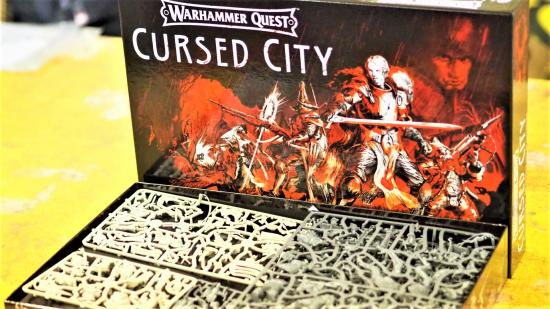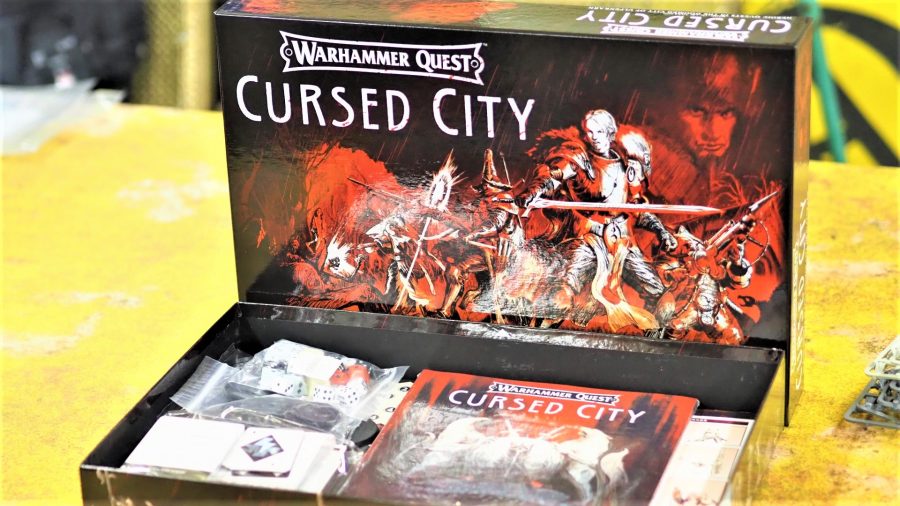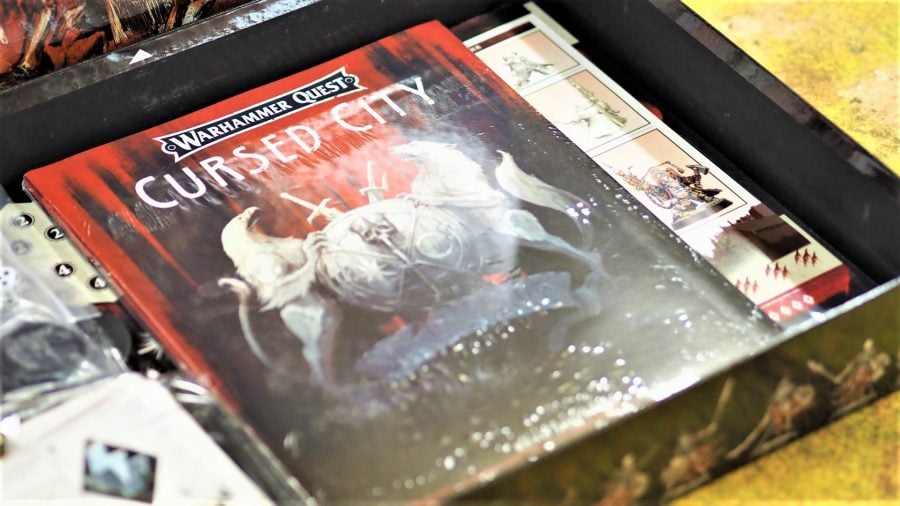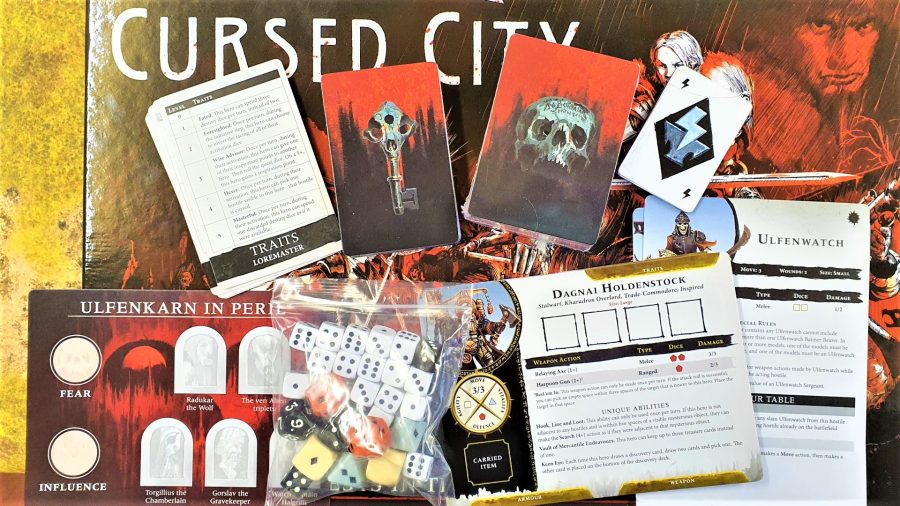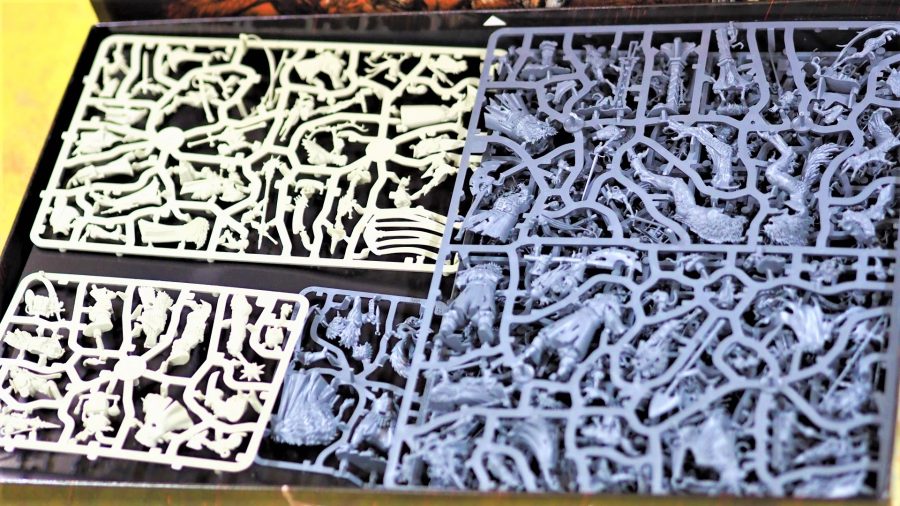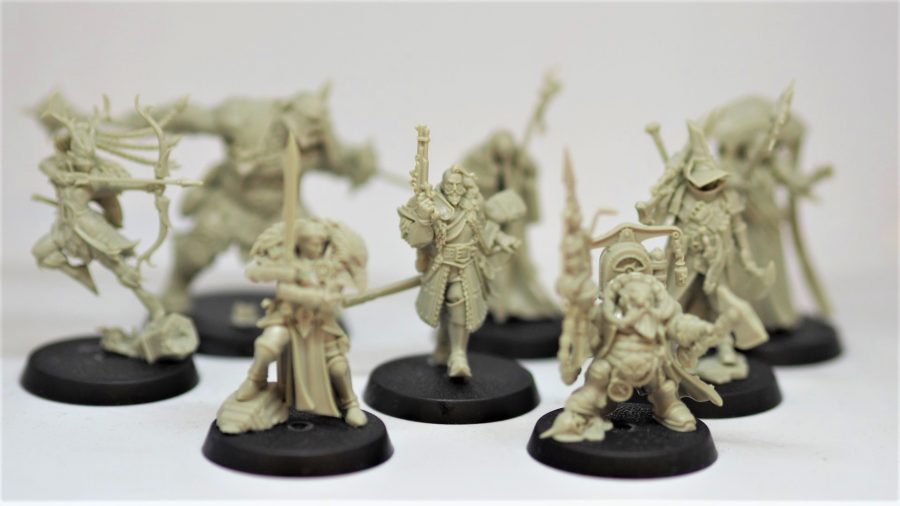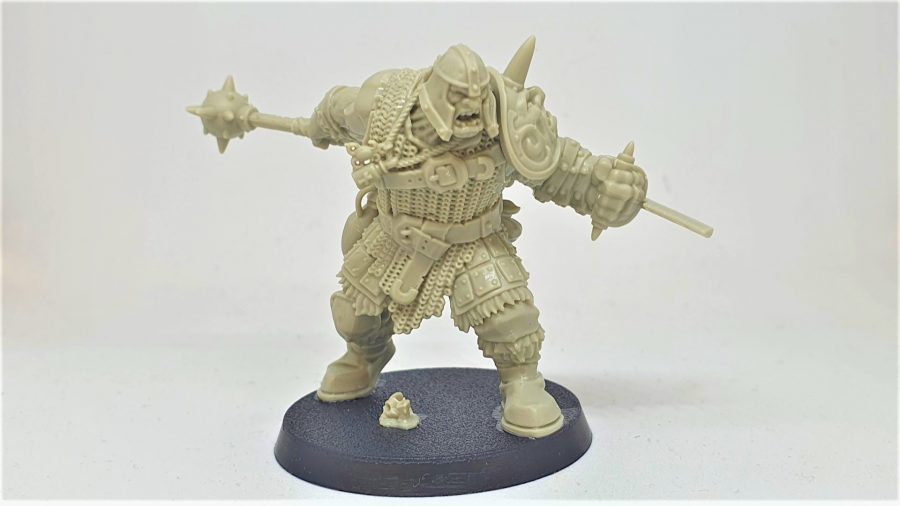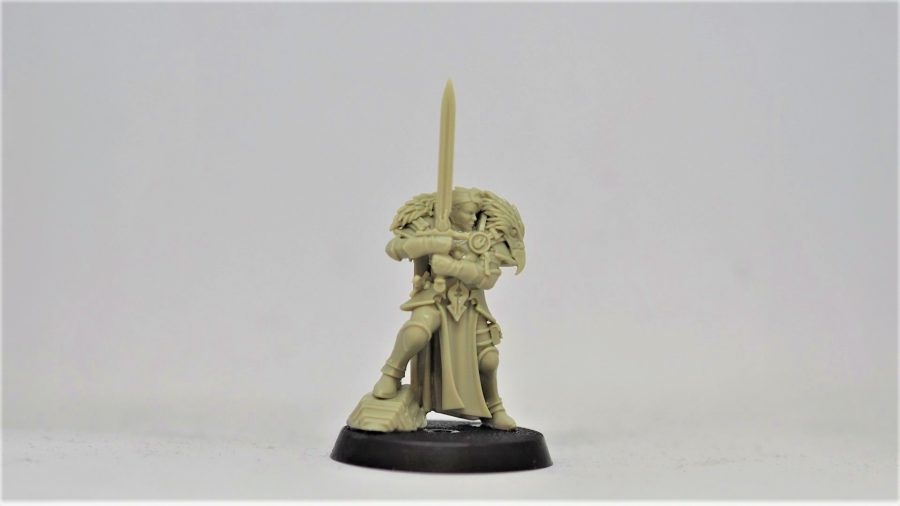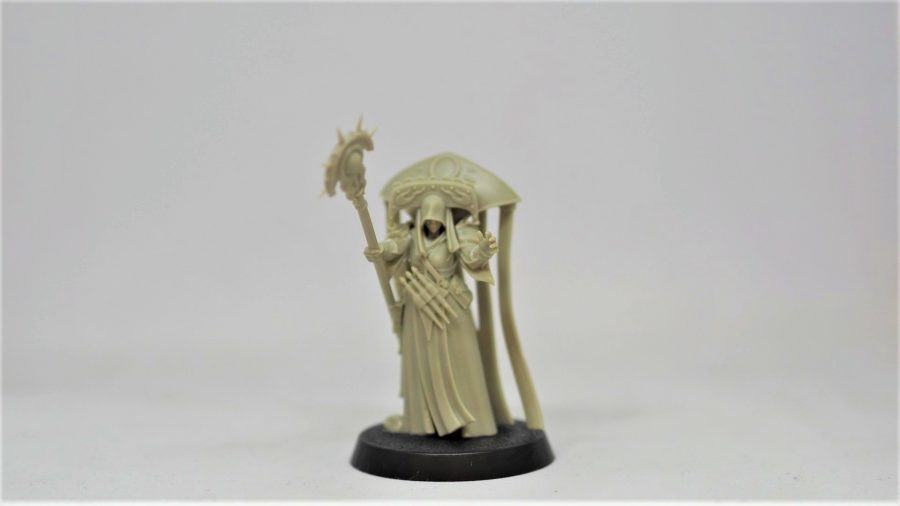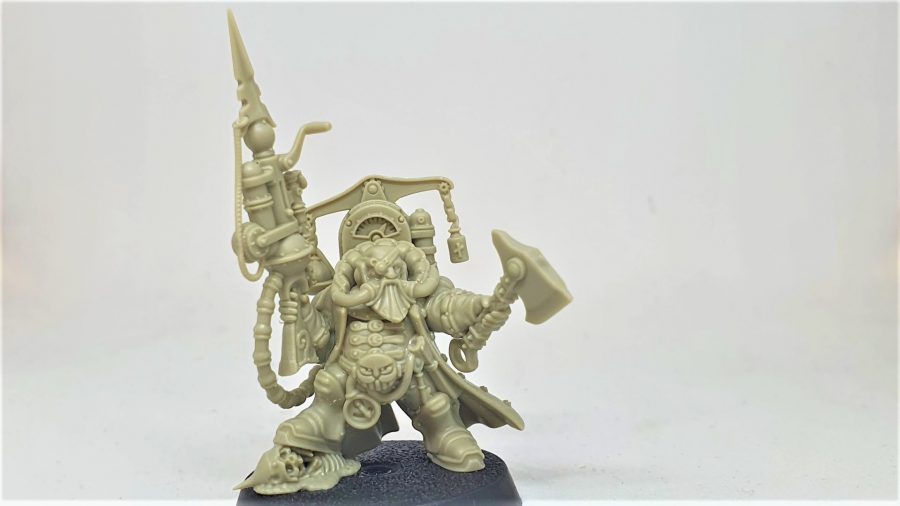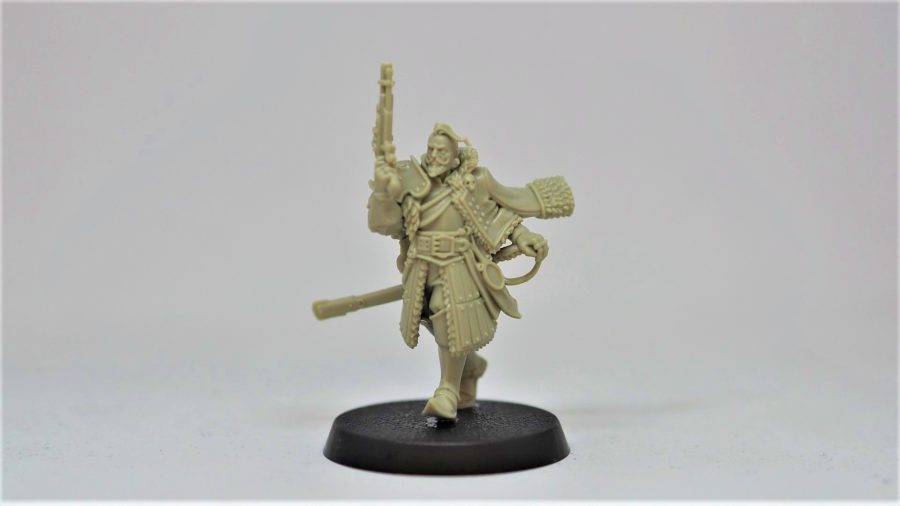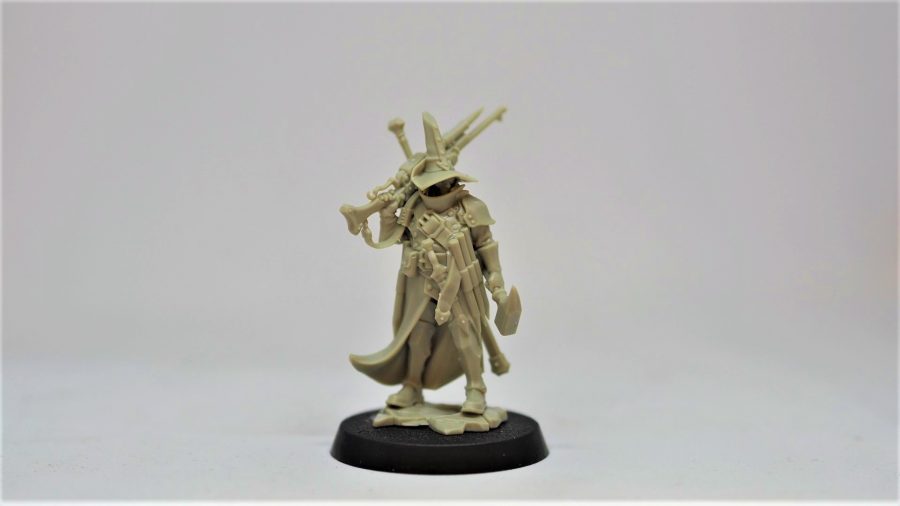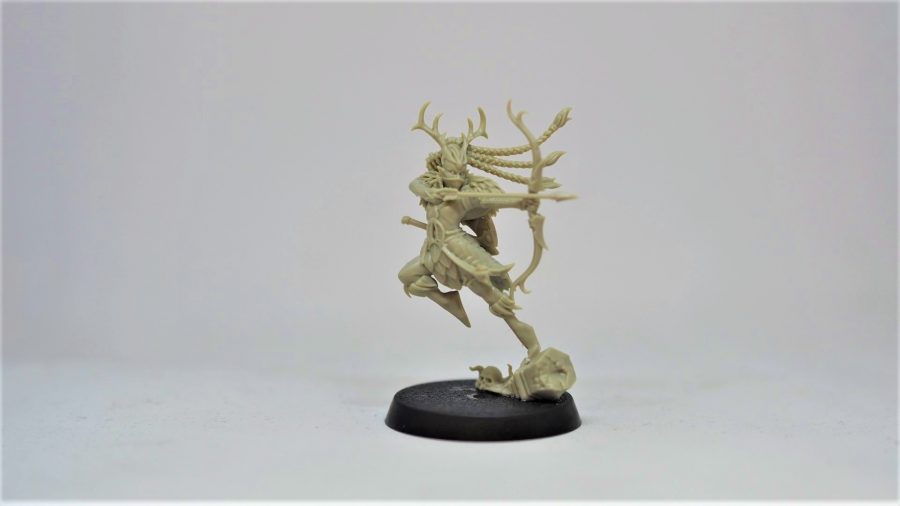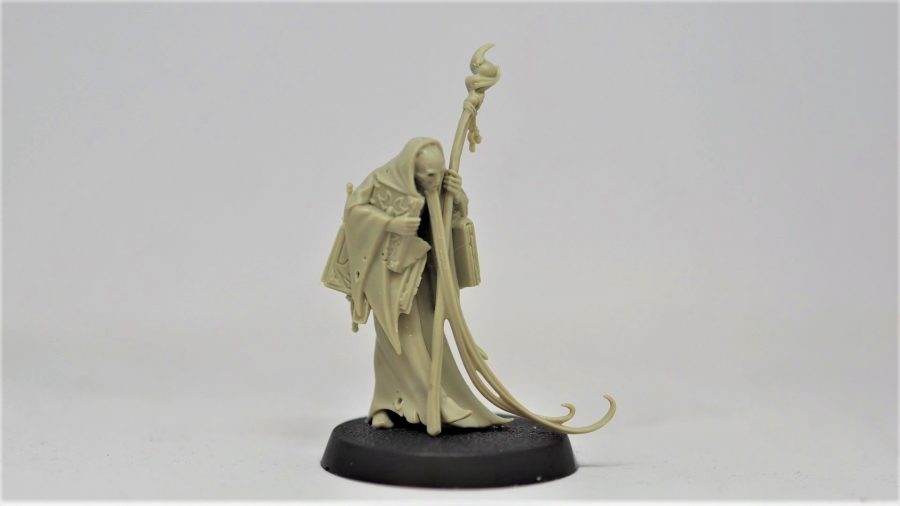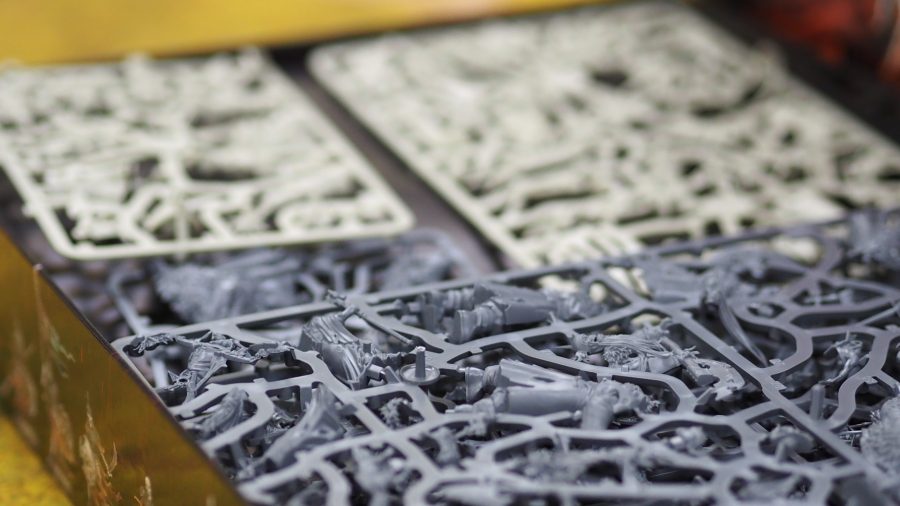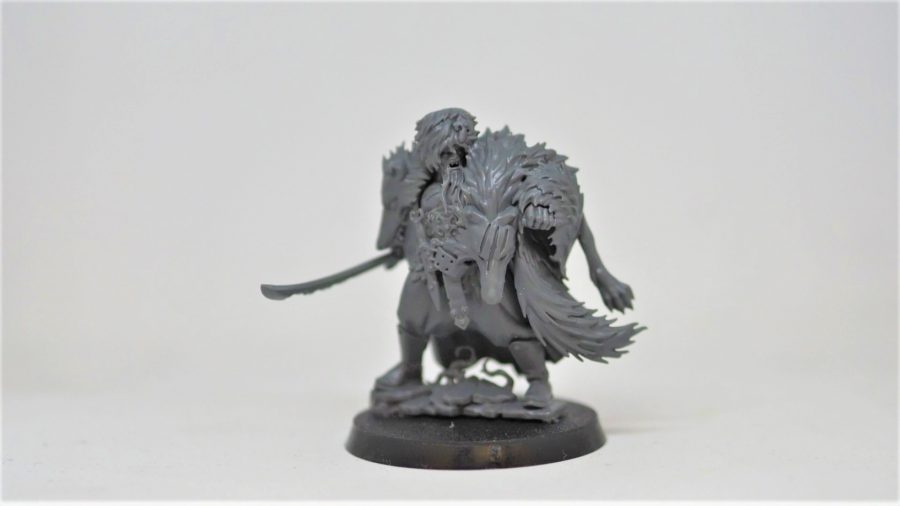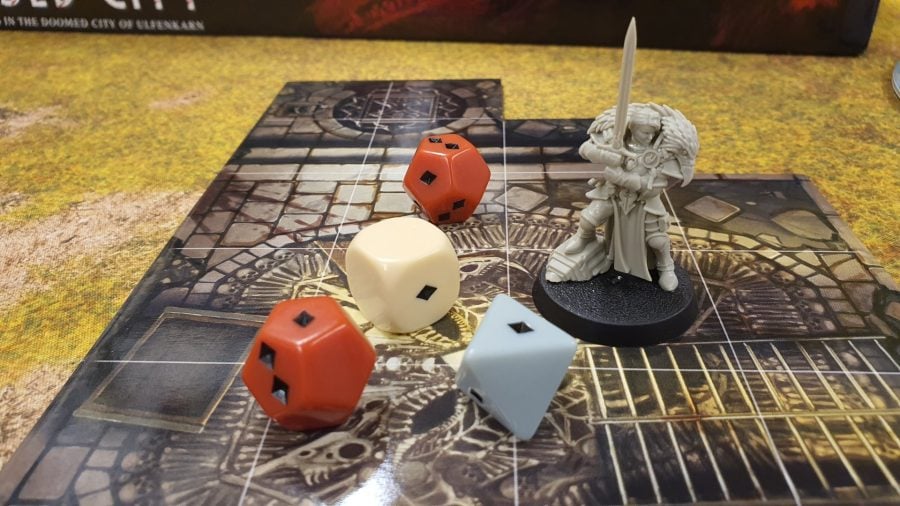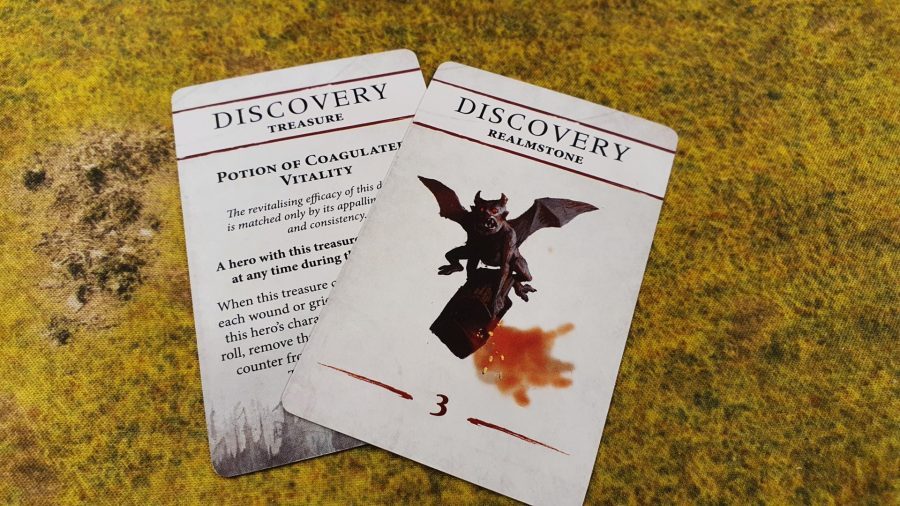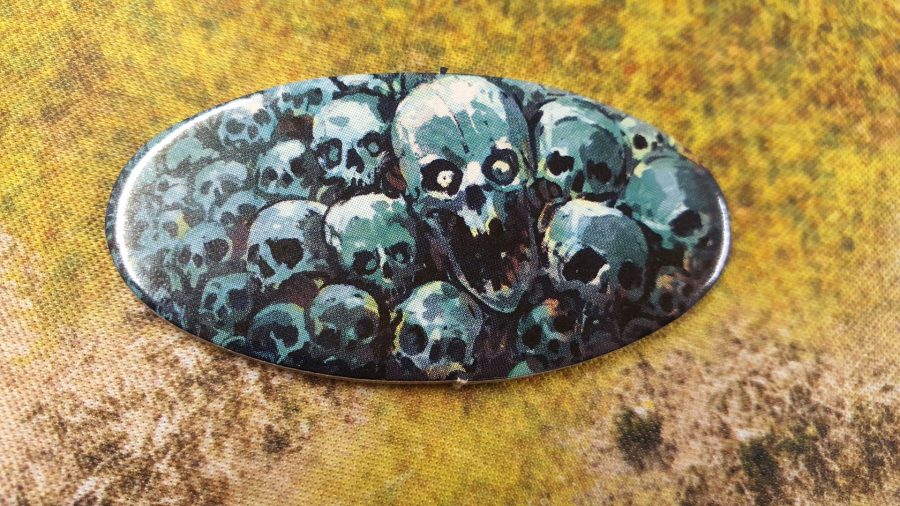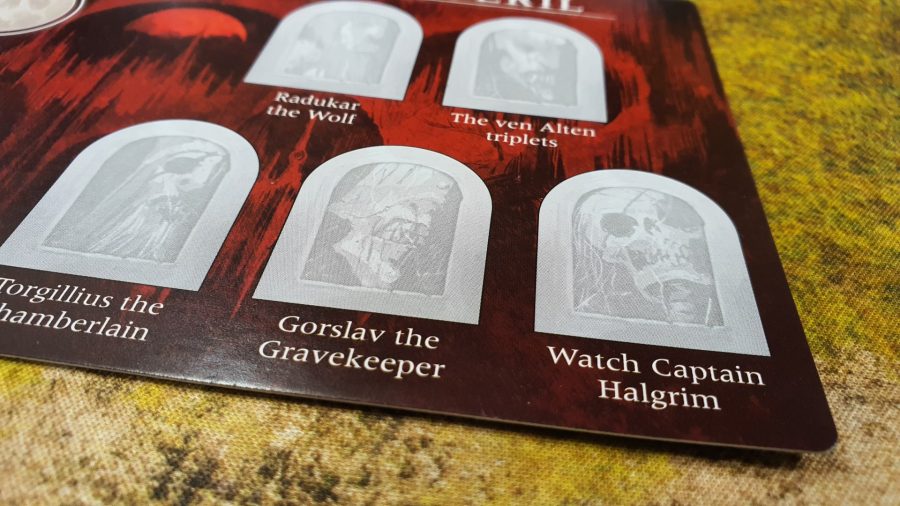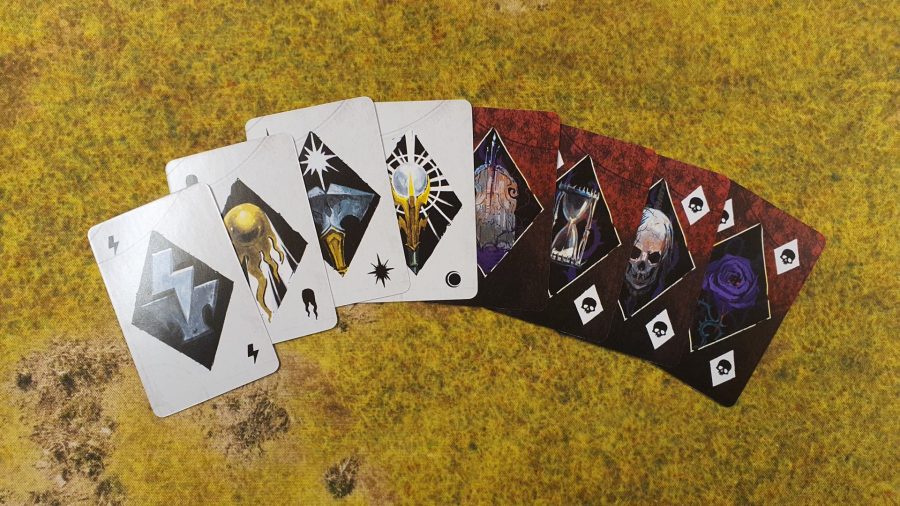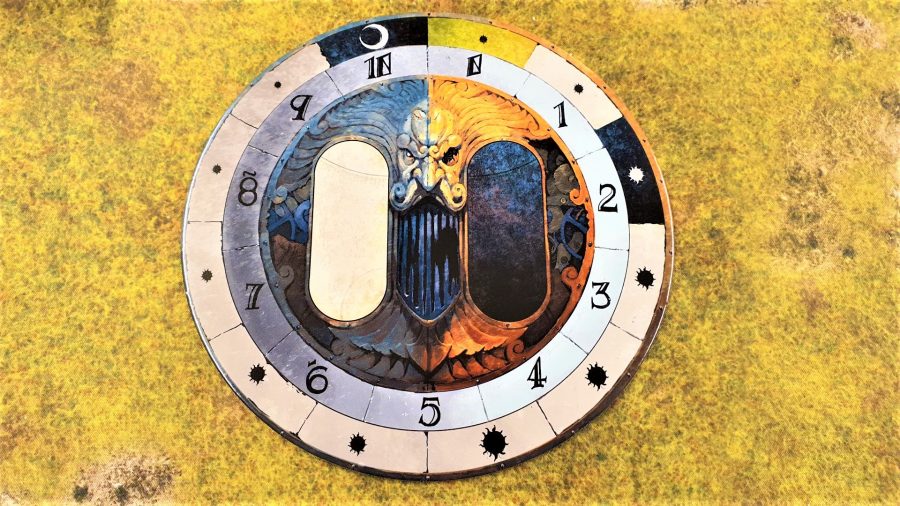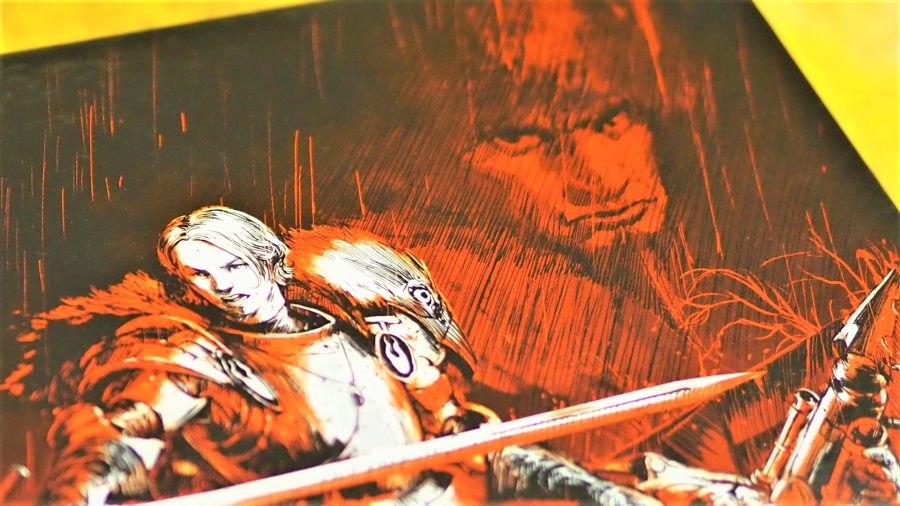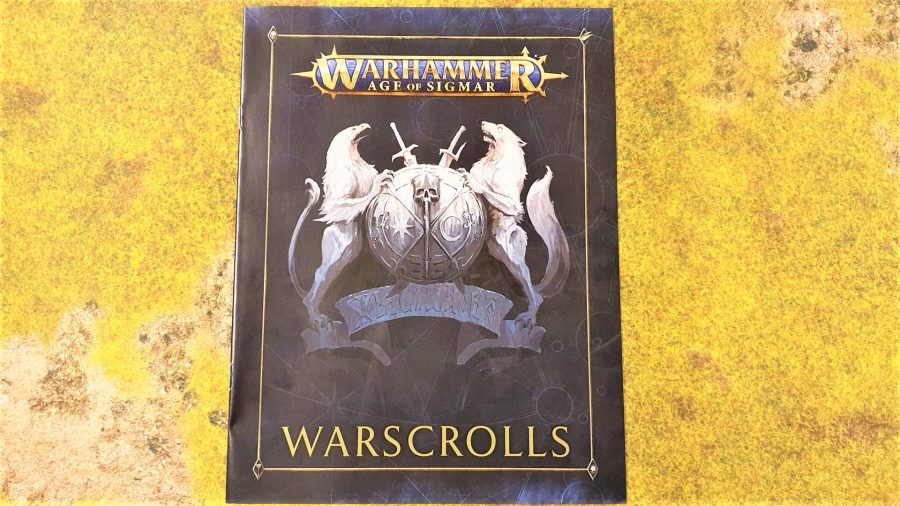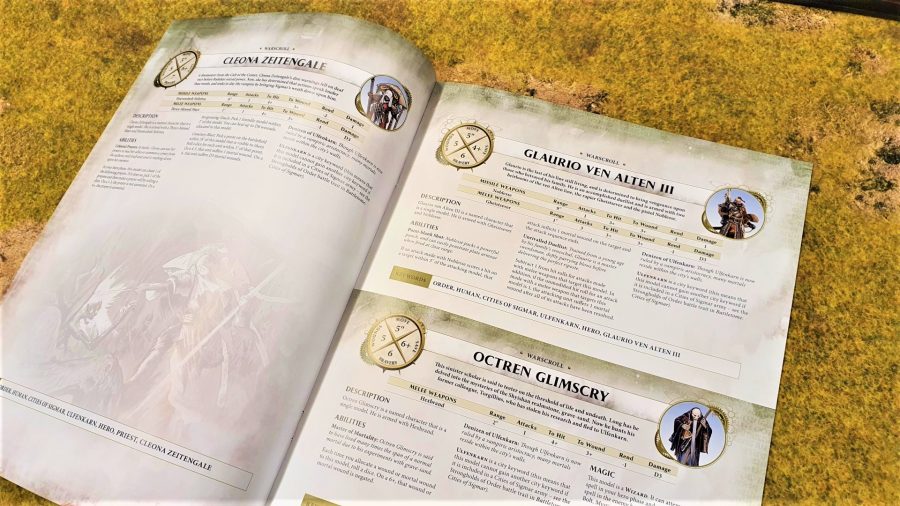It’s here at last (sort of): Warhammer Quest: Cursed City, Games Workshop’s latest narrative-rich miniatures adventure campaign in a box, and a direct fantasy follow-up to the excellent Warhammer Quest: Blackstone Fortress. Like that game, it’s got a cast of character models with more visual personality per gramme of plastic than you’ll find most anywhere else in GW’s lines. Also like that game, it pits your small band of heroes (cooperatively) against increasingly vicious foes, in semi-procedurally-generated, templated missions, within a larger overarching quest.
Unlike its sci-fi sibling, however, Cursed City returns to the Warhammer Quest series’ old fantasy turf, swapping Blackstone Fortress’ mysterious spaceship innards for an Age of Sigmar-flavoured mise-en-scene, in the form of the formerly free city of Ulfenkarn. Don’t fear, though, grimdark fans – it’s barely any cheerier: the benighted streets of the titular settlement are stalked by undead and corrupted beasts of every stripe, commanded by a reputedly invincible vampire lord named Radukar the Wolf. Yep, an unkillable evil vampire in a castle. And guess what your little ol’ mission is, heroes?
Now, before we get into this, one clarification: by necessity of time and resources, this won’t be a full review right away, but more an overview and first impressions; a review in progress. Overjoyed though I was to receive an advance copy of this voluminous boxed set from GW, considering I’ve had fewer full hours with this game than I possess fingers, it simply isn’t fair to pass overall judgement on this colossal beast yet.
Taking into account the broad sweep of its gameplay, the variability in the campaign’s missions (called Journeys), the time required to reach its set-piece boss battles, and the many assorted ancillary jollies your characters can and will find themselves on – this one is going to take a bit of time to have proper conclusions on.
But, even before having made my first proper trips into Ulfenkarn, aboard the skyvessel Adamant, there’s already an awful lot to talk about in this well-stuffed and magnificently illustrated box. So let’s get to it:
WARHAMMER QUEST: CURSED CITY CONTENTS
As anyone would rightfully expect after paying the princely sum of $199 / £125, this is a chonky ol’ box. Much like Blackstone Fortress, Warhammer Quest: Cursed City easily rivals a mid-range monster board game for the sheer volume of gubbins beneath the lid; even after you’ve carefully removed and admired the six frames of models, you’re still barely halfway through the unboxing.
The rules come in two separate booklets: the Rules Book and the Quest Book. The former gives you the turn system, key mechanics, and fundamental nuts and bolts of the game, and does so quite neatly and readably, making learning less painful than I guessed. The latter is pretty much a compendium of rolling tables (and the corresponding procedural permutations) for the events in each of the Journeys you’ll make in Ulfenkarn in Peril, the main story questline that’s covered by the Cursed City boxed game.
Does that splitting-up of base rules from quest-specific content clearly telegraph that there will be further Quests on the way in additional expansions for Cursed City? Why, yes. Yes it does.
Enter the Realms: Our guide to Age of Sigmar starter sets
But really, one look at the massive design resources being lavished on Cursed City across GW’s websites should be proof enough that this particular train is scheduled to keep rolling for a considerable time to come.
You’ll also find:
- Five massive, glossy cardboard sheets of map tiles, trackers and MANY tokens
- A stack of encounter cards, telling you the make-up of the gangs of enemies that’ll come your way
- A smaller stack of discovery cards, describing items, enhancements and other secrets you will come across
- Lovely big datacards for each playable hero, plus equally user-friendly cards for all the enemies’ stats
- Yet more cards explaining level-up options for the game’s hero classes (very cool)
- A single, large Quest Card to track your progress through Ulfenkarn in Peril
- A sixth and final (mini) set of cards, for tracking heroes and enemies’ initiative in fights
- A fat bag of dice; Cursed City uses a bizarre cocktail of standard D6s, custom D6s, D8s and D12s, and a single standard D12 (I don’t know why)
- A booklet of Warscrolls containing rules to play all the included models in games of Age of Sigmar
If anything refined from the already sumptuous presentation of Blackstone Fortress, Cursed City’s materials are a delight at every turn; from the oddly satisfying illusion of depth created by the shiny gloss finish over the cardboard map tiles’ ransacked rooms and cobbled roadways, to the elegant symbol drawings on the tokens and corresponding cards used to track initiatives.
The moody, red-on-black design theme creates a consistent and appropriate-feeling atmosphere, led from the front (quite literally) by one of the finest pieces of box art in modern GW history. It gets a big tick from me in all these boxes. A solid A.
But admit it: the packaging, artwork, dice, and cards ain’t what you’re here for.
WARHAMMER QUEST: CURSED CITY – THE MODELS
These are the real deal, the main event. Open this box up and – as is customary with GW’s larger boxes these days – your dreamt-of plastic mountain is on the topmost layer, immediately assaulting the eye with a cornucopia of rats, bats, swords, chainmail, gravestones, pistols, spellbooks, and more.
Square bases: What to expect from Warhammer The Old World
More than any of GW’s previous push-fit miniatures, these are a dream to put together, leaving almost no gaps behind in their brilliant, lively poses. Obviously, you should still use plastic glue to get ’em nice and neat, though. We’ll start with the heroes (partly because it’s traditional, but mostly because I’ve built them all).
The Heroes
There’s eight in all, but you’ll only be fielding four at any one time, between two to four players.
Here’s who’s on the team sheet:
Brutogg Corpse-Eater
A casual observer could be forgiven for mistaking Brutogg here for one of the baddies. Not so, however, for this Ogor (don’t call him an ogre, whatever you do) is your biggest, tankiest hero.
His motivation? He heard there were a lot of corpses here. And he likes to eat corpses. Probably best to keep a weather eye on this chap.
Captain Emelda Brasko
She’s stern. She’s mean. She’s got full plate armour, neat hair, a big bastard sword and a big bastard eagle on her shoulder. She means business.
Brasko is a ranking officer from an ancient military household in Ulfenkarn, who lost all her 200 soldiers, in one go, when Radukar took over the city, only to see most of them rise again in his service.
Understandably, she’s pissed.
Cleona Zeitengale
Cleona’s wonderfully flowing, absurdly decorative finery quite befits her status as a spell-slinging Sigmarite cultist.
Ulfenkarn’s very own Cassandra of Greek myth, she spent years – before Radukar’s rise to power – desperately trying to convince the city’s common folk of the truth to her visions that an undead takeover was coming.
Presumably every time she fireballs a zombie, she whispers “told ya so”.
Dagnai Holdenstock
A Duardin (dwarf) of the steampunk sky-pirate variety that make up the Kharadron Overlords, Dagnai is the shipmaster of your little band’s airship, the Adamant. He also has a steam-powered harpoon rifle, an eyepatch, and a backpack-mounted scale for measuring precious metals. Nice.
Dagnai’s avaricious character is clear – but so’s the edge on that axe, so don’t mess with the fella if you know what’s good for you.
Glaurio ven Alten III
Gloriously camp and over-dressed in every way (clock the hand-mirror at his belt), Glaurio is a proud, preening duelist, the scion of a noble house of Ulfenkarn – and the sole member of said house who’s neither dead, nor an undead servant of Radukar.
His three cousins, Janus, Loria and Holrik ven Alten, now far from Glaurio’s innocent childhood friends, together make up Cursed City’s penultimate boss fight (can’t wait for the family drama on that one).
Jelsen Darrock
He’s got a witch-finder’s pointy hat and high collar, a rifle with an underslung stake launcher, a bandolier of extra stakes, and a hammer, and a big sword.
Doesn’t take a genius to identify Jelsen as a bona fide, Van Helsingesque vampire hunter – and that seems to be pretty much what he’s about. There’s vampires here; he’s turned up to change that. Perfect if you’re into leather trench coats, big buckles and gruff voices.
Qulathis the Exile
Radukar and his army marched straight through this aelven tracker’s forest home on their way to Ulfenkarn and its lands, slaughtering as they went, and crippling all aelven resistance.
Obsessed with taking revenge, Qulathis stole splinters from her people’s holiest tree to make magical arrows intended to slay the vamp – and they banished her for it. You get tokens representing these arrows in this game. This is extremely cool.
Octren Glimscry
This guy is as dark as his model is spectacularly weird-looking, with a beard of never-before-seen length in plastic miniatures (seriously, it must be some kind of obscure record). Octren is an ancient, perpetually experimenting death mage, whose mastery of the mysterious substance grave-sand brings him supernatural long life.
A founding member of an occult magical order, he was once best mates with Torgillius, Radukar’s Chamberlain and top advisor, but now hunts him down for stealing Octren’s research to help the Wolf. What mysteries lie behind the mask of this slippery, hirsute spellcaster, I wonder?
Screen time: The best Warhammer fantasy videogames
Anyhow – this, to my mind, is a fantastic set of miniatures. Easily on a par with Blackstone Fortress’ supremely characterful adventuring party, Cursed City’s heroes harbour a plethora of pleasing details and textures that’s going to make painting them an entire quest all its own, and bring them to life beautifully in-game. A+.
The Enemies
Not all of these nasties are ready for their Wargamer photo-shoot just yet, but we’ll slip in a profile of the ‘big bad’, early doors, just so you know what’s waiting for you at the top of the castle.
Radukar, The Wolf
Sporting baggy pants, a huge wrestling-belt-esque armour plate over a bare torso, a big shaggy mongol-style fur hat, and two entire shoulder-slung wolf pelts (heads and all), Radukar cuts… well, honestly, a slightly understated figure, for the final boss of such a spook-happy fantasy storyline.
Still, his functional immortality – provided by the mysterious grave-sand technology discovered by his loyal Chamberlain, Torgillius – and the sheer weight of undead minionry at this fanged freak’s command, make Radukar a weighty enough villain.
For now, at least – I’m looking forward to seeing his profile expand a little as my heroes explore the campaign. B+.
CURSED CITY: GAMEPLAY
CAMPAIGN
For now, an overview. Games of Warhammer Quest: Cursed City are organised into Journeys – effectively campaign missions, where your four chosen heroes make a sortie into the accursed streets of Ulfenkarn, to achieve certain objectives within your overall quest – which is to weaken Radukar’s hold on the city by killing his lieutenants one by one, then eventually stake the smug, grisly bastard himself, right in his black heart.
Along the way, you’ll also have to make sure you’re not doing more harm than good for the city’s terrorised populace. With each Journey, you’ll kill off Radukar’s minions, gain experience and collect loot and upgrades – but each also carries a cost in terms of raising the civvies’ fear levels, or else allowing the Wolf more time to consolidate his domineering influence. If either of these trackers reaches ten at any point, it’s game over, kaputt, no dice. Eek.
This, then is Cursed City’s principal metagame: picking your Journeys with care to achieve the right aims in the right order, and keep everyone alive until you can finally cut the head off the snake.
JOURNEYS
Journeys come in four flavours:
Hunt – The simplest, and most accessible of Cursed City’s mission types, Hunt Journeys task you with dropping in, slaughtering as many of Radukar’s fell servants as possible, then hopping back aboard ship and flying away, flipping the medieval fantasy equivalent of the bird to all the thwarted undead below.
You’ll come away with experience, maybe some loot, and, by taking out some of the Wolf’s lackeys, you’ll reduce his Influence. On the other hand, while you swan off back into the sky, the innocent mortals’ Fear goes up, as they begin to dread Radukar’s revenge upon the neighbourhood.
With added dragons: Read our D&D Candlekeep Mysteries review
Scavenge – Similar to Hunts, but generally tougher, and with more potential treasure to bring home. You’ll be using Scavenge Journeys to gather up crucial loot, and the magical equipment-upgrading material Realmstone, to buff your team for the larger quests to come.
But, while you’re rooting about in cupboards looking for tins of strength-enhancing fantasy spinach, the Wolf’s Influence grows, as does the Fear among his victims. Best used sparingly, it would seem.
Deliverance – particularly intriguing – and a new feature for Cursed City – these Journeys don’t have a pre-determined map of tiles to crawl through, like the others.
Instead, the heroes are on the run from an escaped Endless Spell (in this case, a semi-sentient tidal wave made of mortal remains) and must barrel through numerous rooms in quick succession, which are randomly generated, on the fly, as they flee.
This could feel pressurised, and action-packed – or it could drain all the personality out of those gorgeous maps with its rampant randomisation. I really can’t be sure until I’ve given a few of these a try – but the concept, at least, seems a nice, high-energy twist.
Decapitation – These are Cursed City’s six keynote missions, in which you’re looking to make a targeted elimination strike on one of Radukar’s main lieutenants (and, finally, the Wolf himself). Each is essentially a Deliverance Journey with a modified Hunt grafted onto it, for extra questiness.
That ‘hit list’ of Decapitations – each of which can only be attempted once the heroes have reached the requisite level – functions similarly to Assassin’s Creed’s rogues’ gallery of targets. Each time you cross one of these evil sidekicks off your to-murder list, you get to add their ugly little face token permanently to the Quest Card, taking you another head closer to ultimate victory. I absolutely cannot wait to do this part.
GAME MECHANICS
There are a couple of other key in-game mechanics that are significant and/or novel enough that they merit pulling out among these first impressions.
First, we need to talk about Crises. Another new feature since Blackstone Fortress, these are self-contained, dynamic mini-roleplaying events that have a 1/6 chance of triggering on each turn, and send one character off to deal with some issue or other.
Beyond Shyish: Read our guide to Age of Sigmar armies
There’s usually a skill check involved, and sometimes a character decision to be made that will affect the side-quest’s outcome. You might save an innocent citizen and decrease fear, or fail to do so and worsen it. You might come away with a treasure, or an accidental disease.
Akin to the random narrative events in a roleplay-injected strategy game like Hearts of Iron 4 or Crusader Kings 3, these are meant to give you a wider variety of ways to interact with the game, and deepen immersion by involving you in the ‘little things’ going on in the world. If they actually work well, Crises have vast world-building potential. Can’t wait to try ’em.
Also bringing some structure to proceedings – and injecting some urgency to boot – is the game’s day/night cycle. That eye-catching clock-face Skyvessel Board staring out of the box at you isn’t just for show; with each game turn, it ticks around one segment, and if you’re still in the city when it strikes ten, well then, it’s night time, baby – and you know what that means!
Actually, no you don’t. Well, it means all the enemy cards instantly get flipped to their meaner, Empowered sides. The otherworldly fires in skeletons’ eye sockets begin burning brighter; those zombies’ rotting muscles swell unnaturally as the hated sun retreats, and, all of a sudden, your fights are going to get a lot harder. What’s more, if you roll a crisis now, you’ll trigger one from the specific list for night time – and, while I haven’t peeked at them for spoilers’ sake, I’d place a sizeable bet on the nocturnal ones being nastier.
The system lends weight to the already strongly-flavoured ‘creatures of the night’ theme that pervades the game, root and stem. It also bodes well for making the action feel driven, and ensuring that the scariest fights can continue to be scary, even once the heroes have levelled up. I like it rather a lot.
INTO THE CITY
The overall result smells to me like a mouth-wateringly rich buffet of dungeon-crawling gameplay, with a few experimental new seasonings and extras added to the Warhammer Quest recipe we know. Time and Journeys will tell if the flavour profile matches the promising bouquet.
Part of me is still concerned that the environments and mobs could get repetitious (especially in the quasi-procedurally-generated mayhem of the Deliverance Journeys) and I still suspect the lengthy list of turn phases may give rise to deadly, momentum-breaking faff radiation.
Proper planning and prep: The best strategy board games
But overall, Ulfenkarn feels like it’s going to swallow me whole, and, y’know, I’m down for that.
Stay tuned for a more conclusive review in due time, once the Wolf has really had a chance to tear me to shreds, and eat my innards warm.
CURSED CITY: AGE OF SIGMAR RULES
Something of a postscript to this nascent review of Cursed City – but an important one – is the inclusion of full Warscroll rules to use all the included models as part of Warhammer Age of Sigmar armies.
One reason Warhammer Quest: Blackstone Fortress’ core set and expansions sold so well, for so long, was the applicability of its splendid model sculpts to play in matches of Warhammer 40K – though this mainly took the form of proxies (using the Blackstone Fortress miniatures as more attractive-looking stand-in models for other, existing units).
Gratifyingly, in Cursed City, we get a neat, separate pamphlet of Age of Sigmar rules for both the heroes and enemy models included. As for the merits – or otherwise – of these minis on the AoS tabletop, alas, that’s a whole guide in itself, and not, in my book, the point of Cursed City or reviews thereof.
For now, suffice it to say that nobody should be buying this boxed game specifically to use the models to start their Soulblight Gravelords army.
Not only are the skeleton and zombie models’ equipment highly unlikely to be conducive to your early lists, but all the other baddie models from Cursed City must be taken as a whole group, for a whopping 680 points.
Theatre of the Mind: These are the best tabletop RPGs
At face value, this seems incredibly – and unnecessarily – limiting, but we’ll just have to wait for the Soulblight Gravelords Battletome to find out for sure how Radukar & co. will be integrated into the wider army.
For now, though, I’ll have to put all thoughts of Age of Sigmar aside, because I’ve got some packing to do; I’m off on my first Hunt Journey into Ulfenkarn’s shadowy depths.
Wish me luck…
